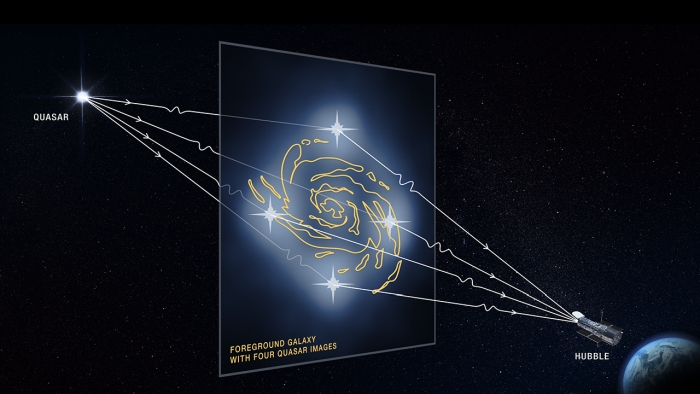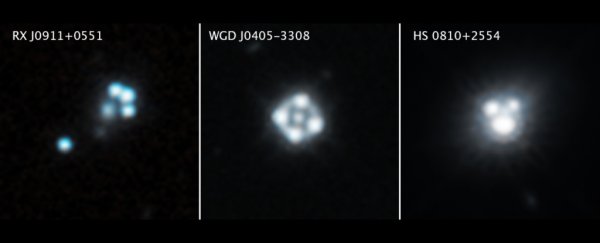A new technique using the Hubble Space Telescope and a feature of general relativity has revealed the smallest clumps of dark matter ever identified - up to 100,000 times less massive than the Milky Way galaxy's dark matter halo.
And these (relatively) teeny tiny clumps of dark matter nicely agree with one of the leading dark matter theories - what astronomers call cold dark matter.
"We made a very compelling observational test for the cold dark matter model and it passes with flying colours," said astrophysicist Tommaso Treu of the University of California, Los Angeles.
We don't actually know what dark matter is. We can't directly detect it. What we do know is that the Universe doesn't behave entirely as it should if we apply our current physics to what we can directly observe. Stars on the outer edges of galaxies, for example, move faster than they should, as though under the influence of some invisible mass.
We call this mass "dark matter," and there are several hypotheses as to how it works. Among them are hot dark matter - where "hot" means "particles moving close to the speed of light"; and cold dark matter, where "cold" means "particles moving at slower-than-relativistic velocities".
Most observational evidence and current models favour cold dark matter, but the case is far from resolved. One test that can offer clues is whether small dark matter clumps can be found.
Hot dark matter, you see, would be moving too fast to allow for smaller chunks. If the dark matter is moving more slowly - as in cold dark matter theory - those small chunks should be out there.
However, finding them is not so easy. Remember the bit about how we can't directly observe it? Instead, astronomers infer its presence based on the gravitational influence it has on the observable matter around it - stars that are moving too fast around the outer edges of galaxies, for example.
Another thing that gravity affects is light. If there is something really massive, such as a galaxy cluster, between us and a light source, the gravitational influence of that cluster curves spacetime, bending the path of the light and creating multiple images of the light source.
 (NASA, ESA, and D. Player/STScI)
(NASA, ESA, and D. Player/STScI)
This is called gravitational lensing, an effect predicted by Einstein's general relativity. In rare instances, the objects involved are lined up in such a way that four distorted images are produced around the lensing object. This is called an Einstein cross.
What's this got to do with cold dark matter, you are wondering? Well, here is the really cool part. The gravitational influence of small dark matter clumps should, in theory, be observable in differences found in each of the images of the background light source that are bent around the lens.
So, the team used the Hubble Space Telescope to study eight Einstein cross quasars, extremely bright galaxies powered by supermassive black holes, gravitationally lensed by massive foreground galaxies.
"Imagine that each one of these eight galaxies is a giant magnifying glass," said UCLA astrophysicist Daniel Gilman.
"Small dark matter clumps act as small cracks on the magnifying glass, altering the brightness and position of the four quasar images compared to what you would expect to see if the glass were smooth."
They measured how the light of the quasars is warped by the lens. They looked at the apparent brightness and position of each of the four images. And they compared these against predictions of how the Einstein crosses should look without dark matter.
These comparisons allowed the team to then calculate the mass of the dark matter clumps altering the images. These clumps seem to be between 10,000 and 100,000 times smaller than the mass of the dark matter in and around the Milky Way.
The findings don't rule out the existence of hot dark matter, of course. (Not to even mention the added complication of mixed dark matter, a model that includes both types.) But these results do add a solid piece of evidence for the existing body of work supporting the existence of cold dark matter.
"Astronomers have carried out other observational tests of dark matter theories before, but ours provides the strongest evidence yet for the presence of small clumps of cold dark matter," said astronomer and physicist Anna Nierenberg of NASA's Jet Propulsion Laboratory.
"By combining the latest theoretical predictions, statistical tools, and new Hubble observations, we now have a much more robust result than was previously possible."
The research has been presented at the 235th meeting of the American Astronomical Society, and published in the Monthly Notices of the Royal Astronomical Society.
